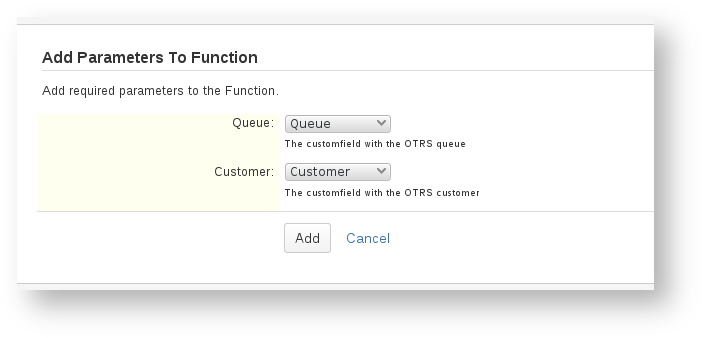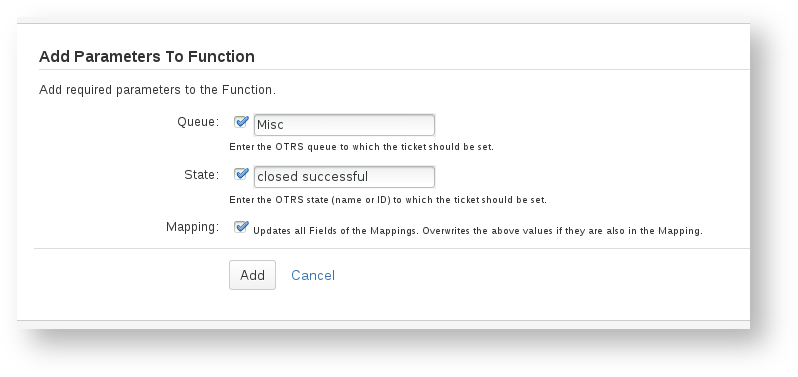
Bei dem JIRA Benutzer mit dem sich das OTRS anmeldet sollte darauf geachtet werden, dass die Sprache auf Englisch eingestellt ist. |
Aktivieren Sie Remote-API-Aufrufe in den JIRA Systemeinstellungen im Administrationsbereich um JIRA Vorgänge aus OTRS heraus anzulegen!!! |
OTRS und JIRA müssen separat konfiguriert werden.
Das Plugin lässt sich über die Konfigurationsdatei 'otrsintegration.properties' anpassen.
Hier müssen unter anderem die URL des OTRS-Systems und die Anmeldedaten angegeben werden.
Wenn die Datei bearbeitet wurde sollte das Plugin einmal deaktiviert und dann wieder aktiviert werden um sicherzustellen, dass die Einstellungen übernommen wurden.
Unterhalb hiervon steht ein Beispiel dieser Datei, inklusive Kommentaren.
Die Konfigurationsdatei muss im conf Ordner unter dem JIRA-Datenverzeichnis platziert werden. Um das JIRA-Datenverzeichnis aus dem JIRA heraus zu ermitteln:
Beispiele:
Sobald das Plugin installiert ist und keine Konfigurationsdatei gefunden werden konnte wird auch eine Fehlermeldung in der Log-Datei ausgegeben mit dem erwarteten Ort. |
# OTRS CONNECTION SETTINGS # The SOAP URL of the OTRS server, e.g. http://localhost/otrs OTRSURL=http://localhost/otrs # The URL of the OTRS server for the Link in JIRA. Leave empty to use the above. OTRSURL_FORLINK= # Specify the username for updating issues in OTRS. OTRS_SOAP_USERLOGIN=root@localhost # Specify the password for updating issues in OTRS. OTRS_SOAP_PASSWORD=root # SPECIAL FIELDNAMES # JIRA Customfield name or ID holding the OTRS ticket ID, e.g. OTRSTicketID OTRSKEY=OTRSTicketID # OTRS Dynamicfield name holding the JIRA issue ID, e.g. JIRAIssueID JIRAKEY=JIRAIssueID # JIRA FILTER SETTINGS # Enter a list of project keys, comma separated, that are used to filter the issues # for those given projects. Leave empty to disable the filter and send mail for all projects. OTRS_PROJECT_FILTER=TEST,OTH # Specify one or more special JIRA user. When this user creates or changes an issue the # OTRS ticket will not be updated. This should in particular include the JIRA user used # by OTRS to update or create issues. JIRA_SPECIAL_USER=otrs2jira # OTRS DEFAULT VALUES # Specify the email address for updating issues in OTRS. This will only be used when # the JIRA user has not specified one. OTRS_SOAP_FROM=me@mail.org # Default values for creating an OTRS Ticket from JIRA. These will be overwritten # by possible mappings. OTRS_DEFAULT_CUSTOMER=Testcustomer OTRS_DEFAULT_QUEUE=Raw OTRS_DEFAULT_STATE=new OTRS_DEFAULT_PRIORITYID=3 # Default TimeUnit value for creating an OTRS Article. This will be overwritten by entered # values (if enabled). Empty values will not be transfered. OTRS_DEFAULT_TIME_UNIT= # Prefix for the OTRS subject field, this will be added to all articles created by JIRA. # You can use a space at the end of the prefix. OTRS_SUBJECT_PREFIX=[JIRA] # JIRA WORKFLOW SETTINGS # Event name for the OTRS workflow commented event, e.g. OTRS_COMMENTED_EVENT. # Only required if a separate workflow transition with event is used for commenting # an issue. Also see the option regarding standard events below. OTRS_COMMENTED_EVENT=OTRS_COMMENTED_EVENT # Event name for the OTRS workflow resolved event, e.g. OTRS_RESOLVED_EVENT. # Also see the option regarding standard events below. OTRS_RESOLVED_EVENT=OTRS_RESOLVED_EVENT # Event name for the OTRS workflow closed event, e.g. OTRS_CLOSED_EVENT. # Also see the option regarding standard events below. OTRS_CLOSED_EVENT=OTRS_CLOSED_EVENT # Set to true, if you also want actions upon standard events on an issue. Use this, # when you do not want or cannot change the workflow events. Set to false otherwise. OTRS_USE_STD_EVENTS=true # COMMENT SETTINGS # Specify whether JIRA standard comments should be transferred to OTRS (true/false) JIRA_COMMENTS_ARE_TRANSFERED_TO_OTRS=true # Specify whether the OTRS Comment Action shows an input field for TimeUnit (true/false) OTRS_COMMENT_WITH_TIME_UNIT=false # Specify whether the TimeUnit field is required for the OTRS Comment Action (true/false) OTRS_COMMENT_WITH_TIME_UNIT_REQUIRED=false # CREATE OTRS TICKET ACTION SETTINGS # JIRA Customfield name or ID holding the OTRS queue (used by the Create OTRS Ticket Action) CUSTOMFIELD_OTRS_QUEUE=Queue # JIRA Customfield name or ID holding the OTRS customer (used by the Create OTRS Ticket Action) CUSTOMFIELD_OTRS_CUSTOMER=Customer # If this is set to false the link to the Create OTRS Ticket Action will not be shown and the # action won't work CREATE_OTRS_TICKET_ACTION_IS_ACTIVE=true # If this is set to true the customer and queue on the Create OTRS Ticket Action will be read-only CREATE_OTRS_TICKET_ACTION_IS_READONLY=false # MAPPING SETTINGS # Mappings from JIRA to OTRS. # A number like in "cust_10100" will be treated as a customfield ID # Mappings from JIRA fields to OTRS Text/Textarea/Dropdown fields MAPPINGS=1,2,4,5,8,9,10 # Mappings from JIRA Date/Time or Date fields to OTRS Date/Time fields DATE_TIME_MAPPINGS=6 # Mappings from JIRA Date/Time or Date fields to OTRS Date fields DATE_MAPPINGS=7 # The actual mappings, if the mapping ID is not listed above it will be ignored MAPPING_1=std_priority,dyn_jirapriority MAPPING_2=cust_10700, dyn_jiramail MAPPING_4=std_components,dyn_JiraComponents MAPPING_5=std_fixForVersion,dyn_JiraFixVersions MAPPING_6=std_created,dyn_SomeDate MAPPING_7=cust_Date,dyn_AnotherDate MAPPING_8=cust_Textarea,dyn_Textarea MAPPING_9=cust_Dropdown,dyn_Dropdown MAPPING_10=cust_OtrsOwner,std_owner # Mapping prefixes you can use (case sensitive): # MAPPING_PREFIX = MAPPING_ # CUSTOMFIELD_PREFIX = cust_ # DYNAMICFIELD_PREFIX = dyn_ # STANDARD_FIELD_PREFIX = std_ # OTRS standard field names you can use (not case sensitive): # queue # title # type # service # sla # state # priority # owner # responsible # customerUser # JIRA standard field names you can use (not case sensitive): # summary # type # reporter # priority # description # key # status # assignee # resolution # votes # id # watches # project # timespent # timeestimate # timeoriginalestimate # created # updated # duedate # resolutiondate # security # environment # components # fixForVersion |
Die obige Konfigurationsdatei ist ein Beispiel. Bitte alle relevanten Werte so setzen, dass sie ihrer Umgebung entsprechen. Insbesondere sollten die Beispiel-Mappings entfernt werden:
|
Weiter müssen folgende Felder angelegt werden wenn sie noch nicht existieren:
Für das Mapping auf OTRS Standardfelder lassen sich die folgenden Bezeichner benutzen (diese sind auch in der Konfigurations-Datei aufgeführt):
queue title type service sla state priority owner responsible customerUser |
Es lassen sich folgende JIRA Standard Feldern im Mapping benutzen und ins OTRS übertragen:
summary type reporter priority description key status assignee resolution votes id watches project timespent timeestimate timeoriginalestimate created updated duedate resolutiondate security environment components fixForVersion |
Wenn Sie den Bearbeiter des JIRA Tickets nach OTRS mappen wollen, müssen Sie sicherstellen, dass im OTRS ein Benutzer mit dem selben Namen existiert. Wenn nicht zugeordnete Tickets erlaubt sind sollten Sie zusätzlich einen Benutzer mit dem Namen "-". Das Mapping dafür wäre zum Beispiel std_assignee,std_responsible. |
Momentan können im OTRS folgende Feld-Typen befüllt werden:
Aus dem JIRA können sämtliche standard Feld-Typen ausgelesen werden. Beim Auslesen von Mehrfachauswahlfeldern sowie den Komponenten und Versionen werden alle Einträge in einer kommaseparierten Liste übergeben.
Keine spezielle Konfiguration nötig.
Es stehen folgende Postfunctions zur Verfügung:

Mit der 'Create Otrs Ticket' Postfunction kann ein OTRS Ticket erzeugt werden. Soll die Postfunction genutzt werden muss diesem einem Workflow hinzugefügt werden. Dann lassen sich die Customfields für den OTRS Kunden und die Queue auswählen:

Um das OTRS Ticket zu aktualisieren steht die 'Update Otrs Ticket' Postfunction zur Verfügung.

Beim Hinzufügen der Postfunction kann der Namen der Queue angeben werden, in die das Ticket verschoben werden soll. Es kann entweder der Name oder die ID des neuen OTRS Status eingetragen werden. Außerdem kann auch die Übertragung aller Felder im Mapping aktiviert werden.

Keine Konfiguration nötig.